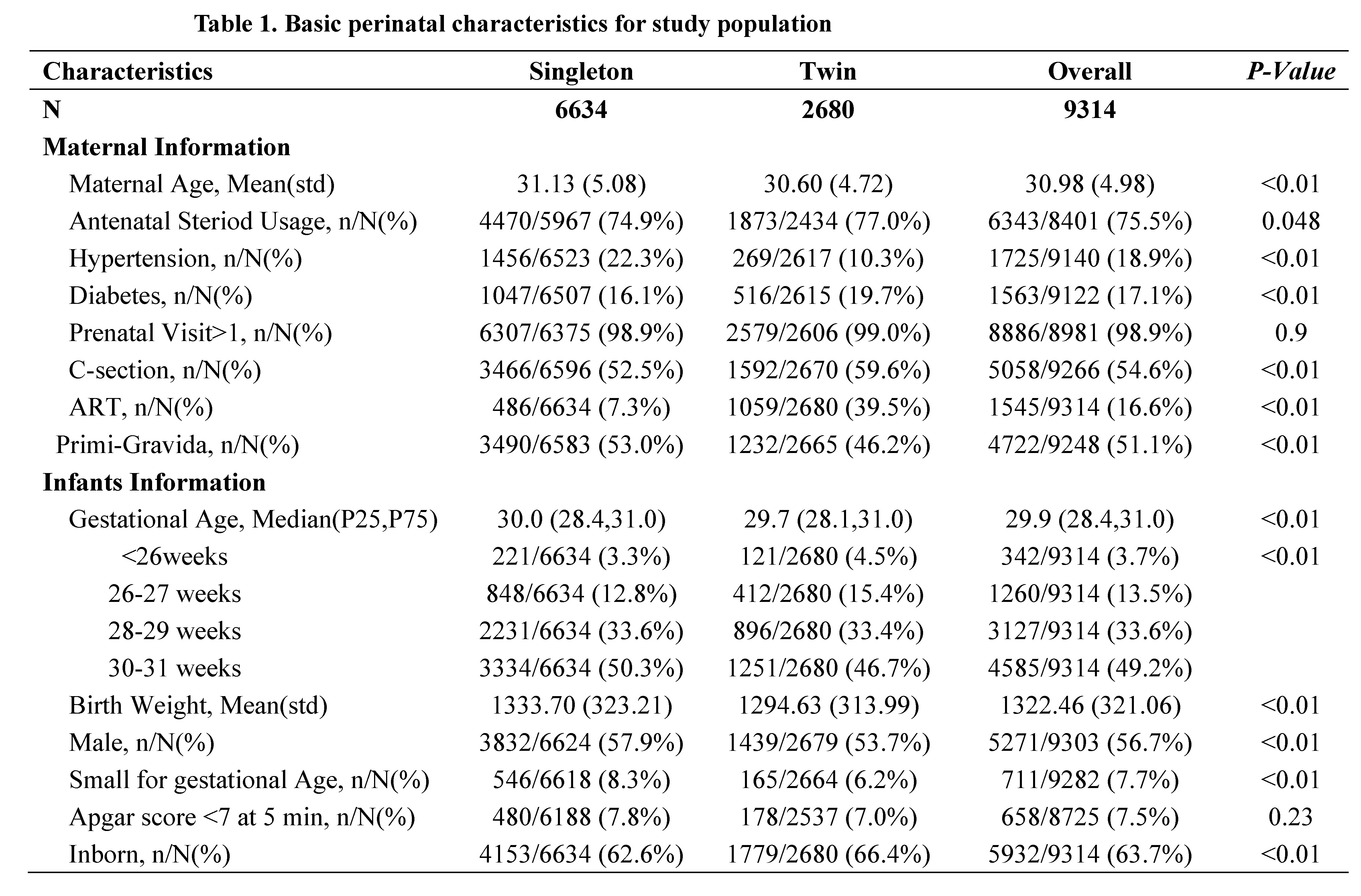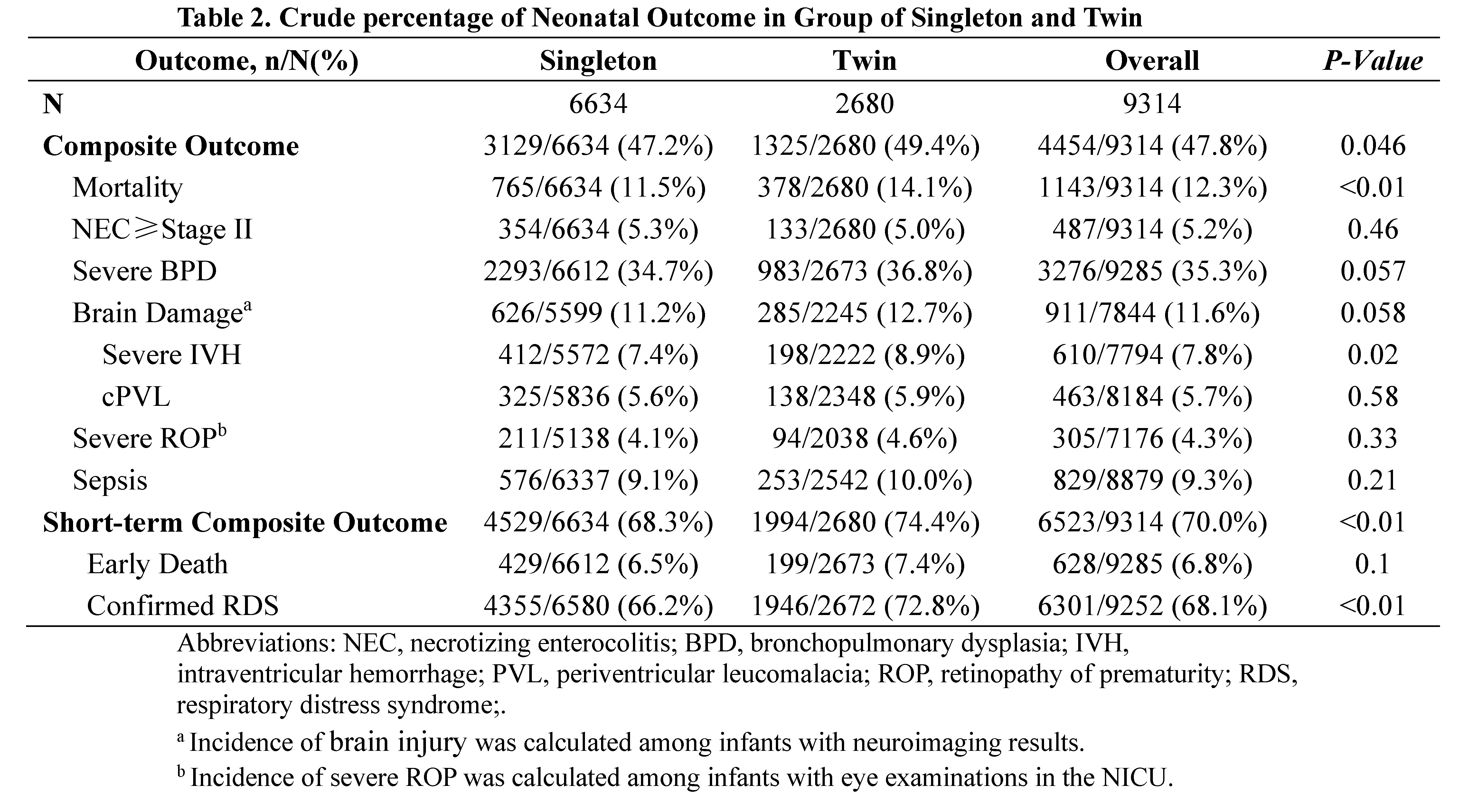Neonatal General
Category: Abstract Submission
Neonatology General 3
380 - Perinatal Characteristics and Neonatal Outcomes of Singletons and Twins in Chinese Very Preterm Birth Infants: A Cohort Study
Friday, April 22, 2022
6:15 PM - 8:45 PM US MT
Poster Number: 380
Publication Number: 380.133
Publication Number: 380.133
Min Yang, Obstetrics and Gynecology Hospital of Fudan University, shanghai, Shanghai, China (People's Republic); Lingyu Fang, Quanzhou Women and Children’s Hospital, Quanzhou, Fujian, China (People's Republic); Yanchen Wang, Children‘s Hospital of Fudan University, Shanghai, Shanghai, China (People's Republic); Xiaoying Li, Shandong Univerdity, Jinan, Shandong, China (People's Republic); Yun Cao, Children's Hospital of Fudan University, Shanghai, Shanghai, China (People's Republic); Jianhua Sun, Shanghai Children's Medical Center, Shanghai Jiao Tong University School of Medicine, Shanghai, Shanghai, China (People's Republic); Dongmei Chen, Quanzhou Women and Children’s Hospital, Quanzhou, Fujian, China (People's Republic); Jimei Wang, Obstetrics and Gynecology Hospital of Fudan University, Shanghai, Shanghai, China (People's Republic)

Min Yang, MD
associate chief physician
Obstetrics and Gynecology Hospital of Fudan University
Shanghai, Shanghai, China (People's Republic)
Presenting Author(s)
Background: National-level data on perinatal characteristics and neonatal outcomes of singletons and twins among very preterm infants (VPIs) are lacking in China.
Objective: To compare the perinatal characteristics and outcomes of singletons and twins admitted to neonatal intensive care units (NICUs) in China.
Design/Methods: This retrospective cohort study was conducted in 57 tertiary hospitals participating in the Chinese Neonatal Network (CHNN). Infants born at less than 32 weeks’ gestation were included in this study. Infants with major congenital anomalies were excluded. The primary outcomes were composite outcome (included mortality or any one of major morbidity including necrotizing enterocolitis (NEC), severe bronchopulmonary dysplasia (BPD), brain damage, severe retinopathy of prematurity (ROP) and sepsis) and short-term composite outcome (including early death and respiratory distress syndrome). Three-level alternating logistic regression was used to compare neonatal outcomes between twins and singletons.
Results: During the study period, a total of 9314 infants were recorded: 6634 (71.2%) singletons and 2680 (28.8%) twins, with median (IQR) gestational age of 29.9 (28.4,31.0) weeks, mean (SD) birth weight of 1322.46 (321.06) g. Twins were significantly more likely to be delivered by cesarean section, to have antenatal steroid usage, to have received assisted reproductive technology (ART), and had higher prevalence of maternal diabetes and fewer were inborn compared with singletons (p < 0.01). After adjusting for potential confounders, twins had higher incidence of short-term composite outcome (adjusted odds ratio [AOR] 1.28, 95% confidence interval [CI] 1.09-1.50), confirmed neonatal respiratory distress syndrome (RDS) (AOR 1.30, 95% CI 1.12-1.50) and mortality (AOR 1.28, 95% CI 1.10-1.49) compared with singletons. Twins were 1.10 times more likely than singletons to have severe bronchopulmonary dysplasia. There were no statistical differences between singletons and twins in the incidence of necrotizing enterocolitis ≥Stage II, brain damage, severe retinopathy of prematurity and early death.Conclusion(s): Twins had a greater risk of mortality, confirmed RDS and severe bronchopulmonary dysplasia (BPD), and were more likely to receive surfactant, and have longer NICU stay compared with singletons among VPIs in China.
Table 1. Basic perinatal characteristics for study population
Table 2. Crude percentage of Neonatal Outcome in Group of Singleton and Twin Abbreviations: NEC, necrotizing enterocolitis; BPD, bronchopulmonary dysplasia; IVH, intraventricular hemorrhage; PVL, periventricular leucomalacia; ROP, retinopathy of prematurity; RDS, respiratory distress syndrome;.
Abbreviations: NEC, necrotizing enterocolitis; BPD, bronchopulmonary dysplasia; IVH, intraventricular hemorrhage; PVL, periventricular leucomalacia; ROP, retinopathy of prematurity; RDS, respiratory distress syndrome;.
a Incidence of brain injury was calculated among infants with neuroimaging results.
b Incidence of severe ROP was calculated among infants with eye examinations in the NICU.
Objective: To compare the perinatal characteristics and outcomes of singletons and twins admitted to neonatal intensive care units (NICUs) in China.
Design/Methods: This retrospective cohort study was conducted in 57 tertiary hospitals participating in the Chinese Neonatal Network (CHNN). Infants born at less than 32 weeks’ gestation were included in this study. Infants with major congenital anomalies were excluded. The primary outcomes were composite outcome (included mortality or any one of major morbidity including necrotizing enterocolitis (NEC), severe bronchopulmonary dysplasia (BPD), brain damage, severe retinopathy of prematurity (ROP) and sepsis) and short-term composite outcome (including early death and respiratory distress syndrome). Three-level alternating logistic regression was used to compare neonatal outcomes between twins and singletons.
Results: During the study period, a total of 9314 infants were recorded: 6634 (71.2%) singletons and 2680 (28.8%) twins, with median (IQR) gestational age of 29.9 (28.4,31.0) weeks, mean (SD) birth weight of 1322.46 (321.06) g. Twins were significantly more likely to be delivered by cesarean section, to have antenatal steroid usage, to have received assisted reproductive technology (ART), and had higher prevalence of maternal diabetes and fewer were inborn compared with singletons (p < 0.01). After adjusting for potential confounders, twins had higher incidence of short-term composite outcome (adjusted odds ratio [AOR] 1.28, 95% confidence interval [CI] 1.09-1.50), confirmed neonatal respiratory distress syndrome (RDS) (AOR 1.30, 95% CI 1.12-1.50) and mortality (AOR 1.28, 95% CI 1.10-1.49) compared with singletons. Twins were 1.10 times more likely than singletons to have severe bronchopulmonary dysplasia. There were no statistical differences between singletons and twins in the incidence of necrotizing enterocolitis ≥Stage II, brain damage, severe retinopathy of prematurity and early death.Conclusion(s): Twins had a greater risk of mortality, confirmed RDS and severe bronchopulmonary dysplasia (BPD), and were more likely to receive surfactant, and have longer NICU stay compared with singletons among VPIs in China.
Table 1. Basic perinatal characteristics for study population

Table 2. Crude percentage of Neonatal Outcome in Group of Singleton and Twin
 Abbreviations: NEC, necrotizing enterocolitis; BPD, bronchopulmonary dysplasia; IVH, intraventricular hemorrhage; PVL, periventricular leucomalacia; ROP, retinopathy of prematurity; RDS, respiratory distress syndrome;.
Abbreviations: NEC, necrotizing enterocolitis; BPD, bronchopulmonary dysplasia; IVH, intraventricular hemorrhage; PVL, periventricular leucomalacia; ROP, retinopathy of prematurity; RDS, respiratory distress syndrome;.a Incidence of brain injury was calculated among infants with neuroimaging results.
b Incidence of severe ROP was calculated among infants with eye examinations in the NICU.
